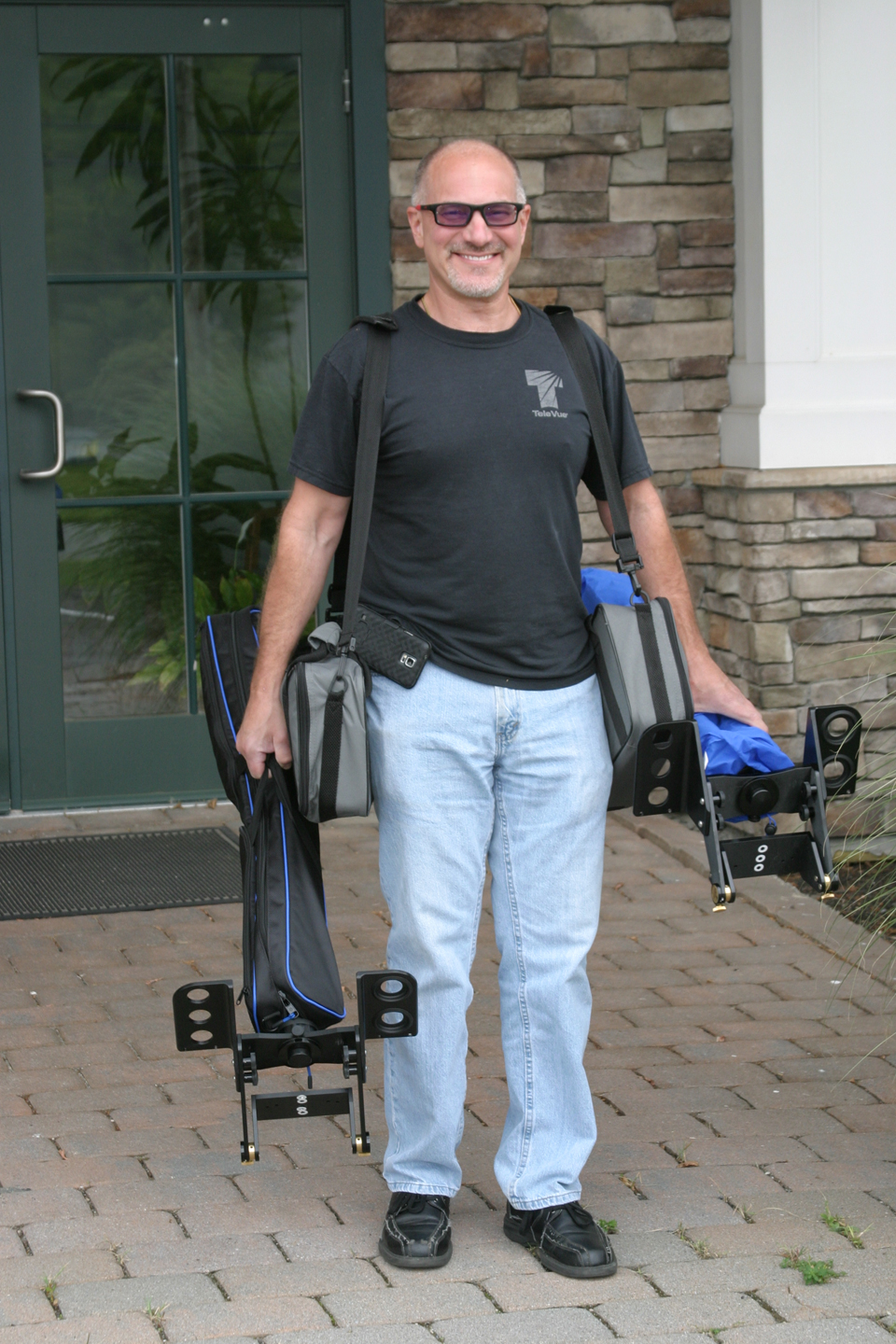Totality in Tellico Plains, TN with Tele Vue TV-85
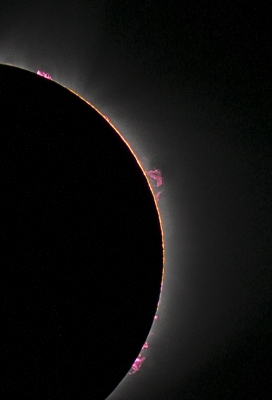
Tele Vue telescopes spread out along the center-line of the Monday, August 21, 2017 North American Eclipse. Our employees and friends report on their eclipse experiences. Our first report is from Peter Carboni, our webmaster and social media blogger. He followed the weather trend before selecting his center-line observing location just 4-days before the event!
After driving 14-hrs Sunday, from the Hudson Valley of NY to a hotel outside of Knoxville, I awoke at 3 a.m. Monday morning for the final 90-min journey to my observing site. At 6 a.m. I arrived in Tellico Plains, Tennessee — population 941 — a farming community in the foothills of the Smoky Mountains that abutted the Cherokee National Forest. It was also near the center-line of the eclipse and promised about 2’ 37” of totality.
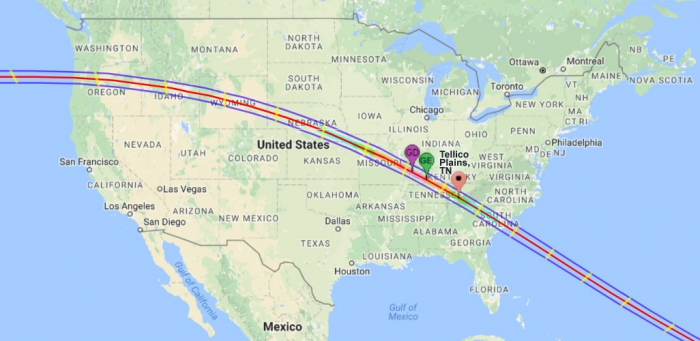
GE = Greatest Eclipse: Moon’s shadow center is closest to center of Earth.
GD = Greatest Duration: the longest totality.
Basemap credit: NASA/Google.
It was still dark in the 16-acre field behind the Charles Hall Museum when I arrived. Other enthusiasts, from all over the country, drove in at the same time. While the bulk of the eclipse chasers would arrive hours later, my early-bird trip earned me a good spot in the first row on the south-side of the field. I only had grasses, a creek, and a few short trees and bushes in the direction of the afternoon sky where totality would take place. My only worry were the clouds. They were present all over the pre-dawn sky.
I waited until after sunrise to setup the following, carefully chosen, pieces of equipment to do my eclipse imaging:
- Tele Vue TV-85 refractor: 85mm, f/7, APO Doublet with standard dual-speed 10:1 Focusmate pinion
- Tele Vue TRF-2008 0.8x Reducer/Flattener: converts TV-85 to 480mm, f/5.6 and provides a mounting point for a camera T-ring
- Tele Vue Focusmate Driver: hand controlled, variable-speed, vibration-free motor focus that allows focusing down 0.0005″ steps
- Baader AstroSolar Visual Solar Filter Film: a white light filter material kept on the telescope for all eclipse phases before and after totality.
- SONY a7 II (ILCE-7M2) full frame mirrorless interchangeable lens camera
- T-ring “Tube” for SONY a7 series: for attachment to the TRF-2008 0.8x Reducer/Flattener while maintaining the 56mm optimal distance between reducer and imaging plane (don’t buy the “skinny” T-ring for this application)
- Vixen Sphinx mount: for daytime alignment and tracking of the Sun
- Toshiba laptop: for software control of the camera through USB cable and image downloading
- 2x portable “jump-start” car batteries: with 12-Volt outlets to power mount and laptop.
- Old smartphone: with alarms set to ring before the various phases of the eclipse.
- Folding table and canopy chair
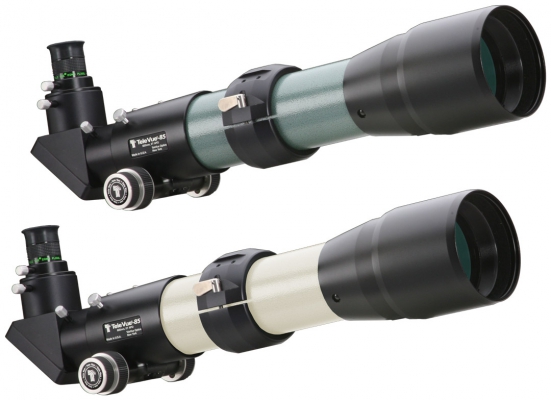
The clouds burned off as the morning progressed for a mostly sunny day. Not wanting to use-up my battery power too soon, I waited until about 10 a.m. to do my first focusing and test shots with the solar filter on the scope and the mount aligned and tracking the Sun. Luckily, sunspot group 2671 had appeared on the limb of the mostly blank Sun in the week before the eclipse. It was now well positioned to use as a focusing target. The focus magnification feature of the SONY a7 II, and the camera’s pull-out LCD screen, came in handy here. I used a jacket over my head to block the daylight to give me better screen contrast as I examined the magnified image of the sunspot on the LCD. Having pre-focused the scope at home, in the days before the eclipse, I only needed to make a few clicks on the in/out buttons of the Focusmate Driver hand controller to confirm I was still at focus. I would repeat the focusing run on the sunspot before the partial phases started and I kept that focus throughout the event.
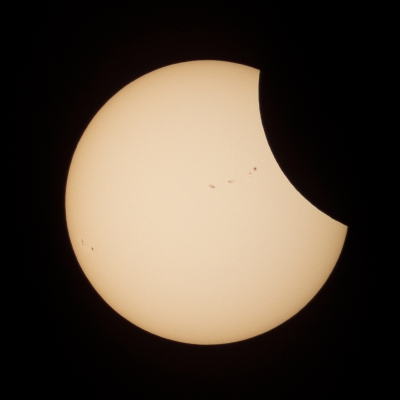
As the temperature hit the low-90s, in strong sunlight, before the partial phases began at 1:04 p.m. EDT, I noticed the LCD screens on my various devices were becoming unreadable due to the heat. Something I hadn’t anticipated. I was forced to stuff a smartphone, hand GPS, and mount controller into the shade of a cardboard shipping box I was using to keep the light off my laptop screen.
Right after 1 p.m. I began a series of timed exposures of the partial phases of the event. This series showed the start of the eclipse until a bit after sunspot 2671 was covered about 40-minutes later.
About 20-minutes before totality it had gotten dark and cool enough that I found it more comfortable to take off my sun hat and sunglasses. My LCD devices were no longer in danger of “heat-stroke” and they came out of the protection of the shipping box.
In the final partial phases, before totality, the light turned sunset-yellow and the breeze died. While the quality of the light had a familiar twilight-feel, it came from high in the sky and without any accompanying long-shadows. The other-worldly lighting added to the anticipation of the event. In the final seconds before totality, the sky dimmed rapidly and the crowd started screaming as we were engulfed in a deep twilight.
One of the alarms on my old smartphone went off to remind me to remove the solar filter. I did so and then clicked down and held the shutter button icon of the software on my laptop to take the first set of bracket images. While the digital camera made its artificial shutter sound and the laptop screen told me that the images were transferring to the laptop, I looked up at the spectacle the crowd was continuing to “oooh” and “ahhh” about.
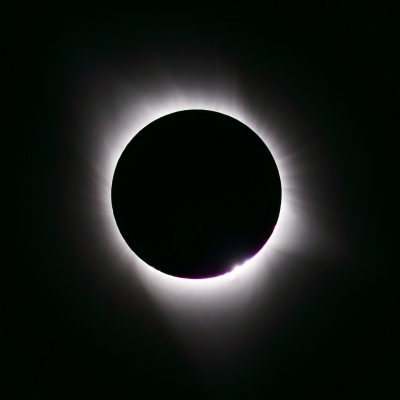
My impression of the eclipse was a black hole in the sky surrounded by diaphanous material through which shown a blinding white light (the solar Corona) that turned the sky blue in its immediate vicinity. Away from the Corona all was nearly black and the Venus shown in the west.
I reset the software several times to take bracketed images around various exposure points — all the while continuing catch a glance of the spectacle above with my eyes. With another alarm chiming on my smartphone, I put the solar filter back in place — the 2’ 37” of totality were over much too soon.
I continued to take timed exposures of the Moon receding from the face of the Sun. By 4 p.m., when the final piece of the Moon left the Sun, I found myself mostly alone in the field and began to pack up for what would turn out to be a 3-hr bumper-to-bumper trip back to my hotel.
- Tele Vue TV-85 telescope webpage (mobile version)
- Tele Vue TRF-2008 0.8x Reducer/Flattener (mobile version)
- Tele Vue Focusmate Driver (mobile version)




